China’s National Bureau of Statistics (NBS) announced today that China’s economy grew 6.9 percent in 2017, beating both the official target set by the authorities and 2016’s economic growth. China’s gross domestic product (GDP) reached 82.71 trillion yuan (about $12.84 trillion) in 2017, with the service sector accounting for more than half of the total.
As The Diplomat noted earlier, China’s GDP growth had slowed since 2010 and hit a 26-year low of 6.7 percent in 2016. The Chinese authorities set a target of 6.5 percent growth for 2017.
The NBS said that the national economy had developed steadily in 2017.
“Consumption was the major growth driver, contributing 58.8 percent to GDP growth last year,” the NBS added.
The apparent performance of China’s economy was even better than the International Monetary Fund’s (IMF) upbeat prediction. In October 2017, the IMF issued its World Economic Outlook, forecasting that 2017 GDP growth for China would be 6.8 percent.
At the same time, China was already forecasting that its GDP growth would be higher than the official target.
In a press conference in October, Ning Jizhe, deputy head of the National Development and Reform Commission (NDRC) and head of the NBS, said: “China will definitely have no problem meeting its economic growth target of around 6.5 percent this year, and may even beat it, as the economy maintains medium to high growth. ”
Despite the upbeat performance, there are still potential risks for China’s economy. As The Diplomat has been following, Zhou Xiaochuan, the governor of China’s central bank — the People’s Bank of China (PBOC) — has issued alarming messages about China’s economy in recent months.
For example, in November 2017, the PBOC published an article by Zhou under the title of “Holding the Bottom Line of No Systemic Financial Risks.” In the article, Zhou urged China to beware of “systemic financial risks.” Zhou said:
China’s financial sector is and will be in a period with high risks that are easily triggered. Under pressure from multiple factors at home and abroad, the risks are multiple, broad, hidden, complex, sudden, contagious, and hazardous. The structural unbalance is salient; law-breaking and disorders are rampant; latent risks are accumulating; [and the financial system’s] vulnerability is obviously increasing. [China] should prevent both the “black swan” events and the “gray rhino” risks.

































